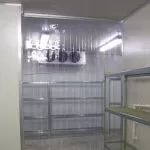Purposes of Pressure Relief Vents in Walk-in Freezers
Purposes of Pressure Relief Vents in Walk-in Freezers
- 24 October 2016
An industrious examination is the only methodology worth adopting when the mechanisms running walk-in freezers need clarification. There are the obvious components, the composite insulating panels and cooling units, parts that require little explanation, but the purposes of pressure relief valves don’t subscribe to easily relatable guides. Instead, this essential component needs its own detailed set of instructions, so let’s begin our engineering-oriented tale by taking a look at pressure equalization needs.
Walk-In Freezers and Pressure Equalization
Fatigue runs up the arms of hard-working employees when they tug the door handle on a walk-in freezer. A pressure differential has built up between the outside of the chamber and its frosty interior. Atmospheric pressure rules outside, but the artificial environment inside the freezer is maintained at a slightly different level. The actions of the cooling unit and its fan are partially responsible for this effect, with the fan drawing warm air out of the sealed room. Pressure release vents (PRVs) equalize this unwanted differential, thus removing the need for muscled arms every time the chilled alcove needs to be accessed.
Accounting for Intrusive Air
There’s typically no airlocks provided outside a walk-in freezer, so the pressure relief vents come to the rescue again when warm air enters the sealed chamber via an open door. Remember, a walk-in freezer door is an invaluable part of the equipment roster, but its functionality is blunted when it’s continually opened and closed throughout the working day. The venting solution handles excess warm air by ejecting it and rebalancing the pressure inside the coolroom environment.
Staying Cool with a Negative Environment
The thermodynamic characteristics of a sealed and cooled freezer dictate the pressure variables we mentioned earlier. Typically, this is a negative value, so the room wishes to address this vacuum by pulling in more air. Unfortunately, this would draw in an airflow that is substantially warmer. The ice would rapidly melt and then refreeze in accordance with the thermostat setting. In short, the interior climate would fluctuate wildly. Fortunately, pressure relief vents prevent these fluctuations by taking care of negative pressure differentials.
Thanks to this valve or venting solution, there’s no longer a need to call on the most musclebound staff member just to open a sealed door. Likewise, negative atmospheric variances are balanced by pressure relief devices, for they’re designed to regulate the internal atmosphere when active fan cooling units and dramatic temperature drops generate undesirable pressure variances
Mark Connelly
C&M Coolroom Services
E-mail : markconnelly@cmcoolrooms.com.au
Mobile: 0412 536 315


